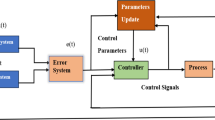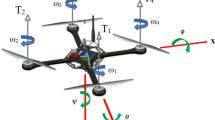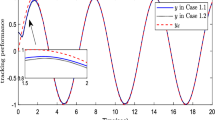Abstract
An event-triggered (ET) neural-networks (NNs) adaptive output-feedback control approach is proposed for a class of input-saturated strict-feedback nonlinear systems with external disturbance. Compared with overall existing event-triggered control strategies, which are free from control input nonlinearities and suffer from the explosion of complexity, the proposed event-triggered-based NNs controller is able to handle system input saturation along with completely avoiding the complexity explosion problem. First, by introducing alternative state variables, and by implementing a low-pass filter, the difficulty arising from the cascading of the input-saturated strict-feedback system has been avoided. Thus, the system is converted to the normal canonical system, for which the controller synthesis is much simpler without resort to traditional back-stepping approach. Then, an observer is adopted to estimate the unknown states of the newly derived canonical system based on strictly positive real theory. In the design procedure, the unknown nonlinear functions are approximated by NNs to design a baseline controller, for which an additional robust term is embedded to deal with the input saturation nonlinearity, unknown disturbances and approximation errors using only two adaptive parameters. The proposed ET adaptive NNs control scheme is shown to guarantee the convergence of the output of the system to a small neighborhood of the origin along with the boundedness of all signals in the closed loop. Finally, simulation examples are presented to show the effectiveness of the proposed controller.












Similar content being viewed by others
References
Zhou, X., Gao, C., Li, Z., Ouyang, X., Wu, L.: Observer-based adaptive fuzzy finite-time prescribed performance tracking control for strict-feedback systems with input dead-zone and saturation. Nonlinear Dyn. 103, 1–17 (2021)
Li, Y., Tong, S., Li, T.: Adaptive fuzzy output-feedback control for output constrained nonlinear systems in the presence of input saturation. Fuzzy Sets Syst. 248, 138–155 (2014)
Liu, H., Chen, G.: Robust trajectory tracking control of marine surface vessels with uncertain disturbances and input saturations. Nonlinear Dyn. 100, 3513–3528 (2020)
Dastres, H., Rezaie, B., Baigzadehnoe, B.: Neural-network-based adaptive backstepping control for a class of unknown nonlinear time-delay systems with unknown input saturation. Neurocomputing 398, 131–152 (2020)
Zerari, N., Chemachema, M.: Robust adaptive neural network prescribed performance control for uncertain CSTR system with input nonlinearities and external disturbance, Neural Comput. Appl, 1–14 (2019)
Zhu, G., Du, J., Li, J., Kao, Y.: Robust adaptive NN tracking control for MIMO uncertain nonlinear systems with completely unknown control gains under input saturations. Neurocomputing 365, 125–136 (2019)
Xu, Q., Wang, Z., Zhen, Z.: Adaptive neural network finite time control for quadrotor UAV with unknown input saturation. Nonlinear Dyn. 98(3), 1973–1998 (2019)
Zerari, N., Chemachema, M., Essounbouli, N.: Adaptive neural control design of MIMO nonaffine nonlinear systems with input saturation. In: International Conference of Electrical Engineering and Control Applications. Springer, Cham, 155–167 (2017)
Swaroop, D., Hedrick, J.K., Yip, P.P., Gerdes, J.C.: Dynamic surface control for a class of nonlinear systems. IEEE Trans. Autom. Control 45(10), 1893–1899 (2000)
Li, T.S., Zou, Z.J., Luo, W.L.: DSC-backstepping based robust adaptive NN control for nonlinear systems. Acta Autom. Sin. 34(11), 1424–1430 (2008)
Wang, D., Huang, J.: Neural network based adaptive dynamic surface control for nonlinear systems in strict-feedback form. IEEE Trans. Neural Netw. 16(1), 195–202 (2005)
Chen, M., Tao, G., Jiang, B.: Dynamic surface control using neural networks for a class of uncertain nonlinear systems with input saturation. IEEE Trans. Neural Netw. Learn. Syst. 26, 2086–2097 (2015)
Edalati, L., Khaki Sedigh, A., Aliyari Shooredeli, M., Moarefianpour, A.: Adaptive fuzzy dynamic surface control of nonlinear systems with input saturation and time-varying output constraints. Mech. Syst. Signal Process. 100, 311–329 (2018)
Homayoun, B., Arefi, M.M., Vafamand, N.: Robust adaptive backstepping tracking control of stochastic nonlinear systems with unknown input saturation: a command filter approach. Int. J. Robust Nonlinear Control 30(8), 3296–3313 (2020)
Yan, X., Chen, M., Qingxian, Wu., Shao, S.: Dynamic surface control for a class of stochastic non-linear systems with input saturation. IET Control Theory Appl. 10(1), 35–43 (2015)
Meng, W., Yang, Q., Jagannathan, S., Sun, Y.: Adaptive neural control of high-order uncertain nonaffine systems: a transformation to affine systems approach. Automatica 50(5), 1473–1480 (2014)
Park, J.H., Kim, S.H., Moon, C.J.: Adaptive neural control for strict-feedback nonlinear systems without backstepping. IEEE Trans. Neural Netw. 20(7), 1204–1209 (2009)
Gao, S., Dong, H., Ning, B., Chen, L.: Neural adaptive control for uncertain nonlinear system with input saturation: state transformation based output feedback. Neurocomputing 159, 17–125 (2015)
Zerari, N., Chemachema, M., Essounbouli, N.: Neural network based adaptive tracking control for a class of pure feedback nonlinear systems with input saturation. IEEE Automatica Sinica 6(1), 278–290 (2019)
Li, Y.X., Yang, G.H.: Adaptive neural control of pure-feedback nonlinear systems with event-triggered communications. IEEE Trans. Neural Netw. Learn. Syst. 29(12), 6242–6625 (2018)
Qiu, J., Sun, K., Wang, T., Gao, H.: Observer-based fuzzy adaptive event-triggered control for pure-feedback nonlinear systems with prescribed performance. IEEE Trans. Fuzzy Syst. 27(11), 2152–2162 (2019)
Zhu, Z.C., Pan, Y.N., Zhou, Q., Lu, C.X.: Event-triggered adaptive fuzzy control for stochastic nonlinear systems with unmeasured states and unknown backlash-like hysteresis. IEEE Trans. Fuzzy Syst (2020). https://doi.org/10.1109/TFUZZ.2020.2973950
Xing, L., Wen, C., Liu, Z., Su, H., Cai, J.: Event-triggered adaptive control for a class of uncertain nonlinear systems. IEEE Trans. Autom. Control 62(4), 2071–2076 (2017)
Ling, S., Wang, H., Liu, P.X.: Fixed-time adaptive event-triggered tracking control of uncertain nonlinear systems. Nonlinear Dyn 100, 3381–3397 (2020). https://doi.org/10.1007/s11071-020-05578-7
Su, X., Liu, Z., Lai, G.: Event-triggered robust adaptive control for uncertain nonlinear systems preceded by actuator dead-zone. Nonlinear Dyn. 93(2), 219–231 (2018)
Wang, L., Chen, C.P., Li, H.: Event-triggered adaptive control of saturated nonlinear systems with time-varying partial state constraints. IEEE Trans. Cybern. 50(4), 1485–1497 (2020)
Choi, Y.H., Yoo, S.J.: Event-triggered output-feedback tracking of a class of nonlinear systems with unknown time delays. Nonlinear Dyn. 96(2), 959–973 (2019)
Zhang, Y.H., Sun, J., Liang, H.J., Li, H.Y.: Event-triggered adaptive tracking control for multiagent systems with unknown disturbances. IEEE Trans. Cybern. (2020). https://doi.org/10.1109/TCYB.2018.2869084
Zhang, C.L., Chen, Z.C., Wang, J.H., Liu, Z., Chen, C.L.P.: Fuzzy adaptive two-bit-triggered control for a class of uncertain nonlinear systems with actuator failures and dead-zone constraint. IEEE Trans. Cybern. (2020). https://doi.org/10.1109/TCYB.2020.2970736
Cao, L., Li, H., Dong, G., Lu, R.: Event-Triggered Control for Multiagent Systems With Sensor Faults and Input Saturation. IEEE Trans. Syst. Man. Cybern. Syst. (2019)
Zhang, K., Zhao, T.: Dynamic output feedback control for nonlinear networked control systems with a two-terminal event-triggered mechanism. Nonlinear Dyn. (2020). https://doi.org/10.1007/s11071-020-05635-1
Li, Y.X., Yang, G.H.: Observer-based fuzzy adaptive event-triggered control co-design for a class of uncertain nonlinear systems. IEEE Trans. Fuzzy Syst. 26(3), 1589–1599 (2017)
Polycarpou, M.M., Ioannou, P.A.: A robust adaptive nonlinear control design”. Automatica 32(3), 423–427 (1996)
Chemachema, M., Belarbi, K.: Direct adaptive neural network controller for a class of nonlinear systems based on fuzzy estimator of the control error. Int. J. Syst. Sci. 42(7), 1165–1173 (2011)
Funahashi, K.L.: On the approximate realization of continuous mapping by neural networks. Neural Netw. 2, 183–192 (1989)
Chemachema, M., Belarbi, K.: Robust direct adaptive controller for a class of nonlinear systems based on neural networks and fuzzy logic systems.". Int. J. Artif Intell. Tools 16(03), 553–560 (2007)
Hornik, K., Stinchombe, M., White, H.: Multilayer feedforward networks are universal approximators. Neural Netw. 2, 1083–1112 (1989)
French, M., Rogers, E.: Approximate models for adaptive feedback linearization. Int. J. Control 68(6), 1305–1321 (1997)
Boulkroune, A., Bounar, N., Farza, M.: Indirect adaptive fuzzy control scheme based on observer for nonlinear systems: a novel SPR-filter approach. Neurocomputing 135(5), 378–387 (2014)
Sastry, S., Isidori, A.: Adaptive control of linearizable systems. IEEE Trans. Autom. Control 34(11), 1123–1131 (1989)
Slotine, J.E., Li, W.: Applied nonlinear control, Englewood Cliffs, NJ: Prentice-Hall, 199(1), 1991
Chen, C.T.: Linear system theory and design. Oxford University PressInc, New York (1999)
Johansson, K.H., Egerstedt, M., Lygeros, J., Sastry, S.: On the regularization of Zeno hybrid. Automata Syst. Control. Lett. 38(3), 141–150 (1999)
Zhou, J., Wen, C.: Adaptive backstepping control of uncertain systems: nonsmooth nonlinearities. interactions or time-variations. New York, NY, USA: Springer-Verlag, (2008)
Malik, S.C., Arora, S.: Mathematical analysis. New Agse Int. (1992)
Author information
Authors and Affiliations
Corresponding author
Ethics declarations
Conflict of interest
The authors declare that they have no known competing financial interests or personal relationships that could have appeared to influence the work reported in this paper. The authors declare the following financial interests/personal relationships which may be considered as potential competing interests:
Additional information
Publisher's Note
Springer Nature remains neutral with regard to jurisdictional claims in published maps and institutional affiliations.
Appendix
Appendix
Proof of Lemma 2
Let \(f\left( \cdot \right)\) be a new functional of the independent variables \( \overline{x}_{n - 1 } ,x_{n} \) and \(s\) such as
\(f\left( {\overline{x}_{n - 1 } ,x_{n} ,s} \right) = \varphi \left( {\overline{x}_{n - 1 } ,x_{n} } \right) - s\).
The equation \(f\left( {\overline{x}_{n - 1 } ,x_{n} ,s} \right) = 0\) has the trivial explicit solution \(s = \varphi \left( {\overline{x}_{n - 1 } ,x_{n} } \right)\) for which \(f\left( {\overline{x}_{n - 1 } ,x_{n} ,\varphi \left( {\overline{x}_{n - 1 } ,x_{n} } \right)} \right) = 0\). However, we can show that this solution can, alternatively and implicitly, be given by \(x_{n} = h\left( {\overline{x}_{n - 1 } ,s} \right)\) for which \(f\left( {\overline{x}_{n - 1 } ,h\left( {\overline{x}_{n - 1 } ,s} \right),s} \right) = 0\).
First, for every fixed values \(\overline{x}_{{\left( {n - 1} \right)_{0} }} \) and \(s_{0}\), \(f\left( {\overline{x}_{{\left( {n - 1} \right)_{0} }} ,x_{n} ,s_{0} } \right) = 0\) becomes a function of \(x_{n}\) only. Since \(\frac{{\partial f\left( {\overline{x}_{{\left( {n - 1} \right)_{0} }} ,x_{n} ,s_{0} } \right)}}{{\partial x_{n} }} = \frac{{\partial \varphi \left( {\overline{x}_{{\left( {n - 1} \right)_{0} }} ,x_{n} } \right)}}{{\partial x_{n} }} > 0\), which means that \(f\left( {\overline{x}_{{\left( {n - 1} \right)_{0} }} ,x_{n} ,s_{0} } \right)\) is strictly increasing, so using the implicit function theorem [45], for every point \(\left( {\overline{x}_{{\left( {n - 1} \right)_{0} }} ,s_{0} } \right)\) the equation \(f\left( {\overline{x}_{{\left( {n - 1} \right)_{0} }} ,x_{{n_{0} }} ,s_{0} } \right) = 0\) determines implicitly one and only one value \(x_{{n_{0} }} = h\left( {\overline{x}_{{\left( {n - 1} \right)_{0} }} ,s_{0} } \right)\) for which \(f\left( {\overline{x}_{{\left( {n - 1} \right)_{0} }} ,h\left( {\overline{x}_{{\left( {n - 1} \right)_{0} }} ,s_{0} } \right),s_{0} } \right) = 0\).
To generalize, the conditions of the implicit function theorem are fulfilled since \( \frac{\partial s}{{\partial x_{n} }} = 0\), and we have that \(\partial \overline{x}_{n - 1 } /\partial x_{n} = 0\) and \(\partial \varphi \left( {\overline{x}_{n - 1 } ,x_{n} } \right)/\partial x_{n} > 0\), then
\(\frac{{\partial f\left( {\overline{x}_{n - 1 } ,x_{n} ,s} \right)}}{{\partial x_{n} }} = \frac{{\partial \varphi \left( {\overline{x}_{n - 1 } ,x_{n} } \right)}}{{\partial x_{n} }} + \frac{{\partial \varphi \left( {\overline{x}_{n - 1 } ,x_{n} } \right)}}{{\partial \overline{x}_{n - 1 } }}\frac{{\partial \overline{x}_{n - 1 } }}{{\partial x_{n} }} - \frac{\partial s}{{\partial x_{n} }} = \frac{{\partial \varphi \left( {\overline{x}_{n - 1 } ,x_{n} } \right)}}{{\partial x_{n} }} > 0\), which means that \(f\left( {\overline{x}_{n - 1 } ,x_{n} ,s} \right)\) is strictly increasing for every \( x_{n}\); then, using the implicit function theorem, for every point \(\left( {\overline{x}_{n - 1 } ,s} \right)\) the equation \(f\left( {\overline{x}_{n - 1 } ,x_{n} ,s} \right) = 0\) determines a unique implicit function \(x_{n} = h\left( {\overline{x}_{n - 1 } ,s} \right)\) for which \(f\left( {\overline{x}_{n - 1 } ,h\left( {\overline{x}_{n - 1 } ,s} \right),s} \right) = 0\).
Rights and permissions
About this article
Cite this article
Zerari, N., Chemachema, M. Event-triggered adaptive output-feedback neural-networks control for saturated strict-feedback nonlinear systems in the presence of external disturbance. Nonlinear Dyn 104, 1343–1362 (2021). https://doi.org/10.1007/s11071-021-06351-0
Received:
Accepted:
Published:
Issue Date:
DOI: https://doi.org/10.1007/s11071-021-06351-0




